| M53/59 Praga | |
|---|---|
 M53/59 Praga, self-propelled anti-aircraft gun of Serbian Army | |
| Type | Self-propelled anti-aircraft gun |
| Place of origin | Czechoslovakia |
| Production history | |
| Designed | 1957 |
| Manufacturer | Engineering and metallurgical plants, Trenčín-Kubrá plant (1959–1961) Škoda Works |
| Produced | 1959–1978 |
| No. built | More than 1000+[1] |
| Specifications | |
| Mass | 10.3 tonnes |
| Length | 6.92 m (22 ft 8 in) |
| Barrel length | 2.4 m (94 in) |
| Width | 2.35 m (7 ft 9 in) |
| Height | 2.95 m (9 ft 8 in) |
| Crew | 4 (driver, commander and two gun operators) |
| Shell | Fixed QF 30x210mmCz |
| Caliber | 30 mm (1.2 in) |
| Barrels | 2 |
| Elevation | -10° - +85° |
| Traverse | 360° |
| Rate of fire | 500 rpm per barrel cyclic 100 rpm per barrel practical |
| Muzzle velocity | 1,000 m/s (3,300 ft/s) |
| Effective firing range | 3 km (2 mi) effective range[2] |
| Armor | Aluminum |
Main armament | 30 mm twin AA autocannon (900 rounds) |
| Engine | Tatra T 912-2 6-cylinder inline air-cooled diesel 110 hp (82 kW) at 2,200 rpm |
| Power/weight | 10.7 hp/tonne (8 kW/tonne) |
| Suspension | leaf spring |
Operational range | 500 km (310 mi) |
| Maximum speed | 60 km/h (37 mph) |
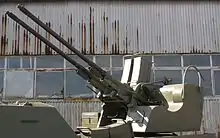
The M53/59 Praga is a Czechoslovak self-propelled anti-aircraft gun developed in the late 1950s. It consists of a heavily modified Praga V3S six-wheel drive truck chassis, armed with a twin 30 mm AA autocannon mounted on the rear for which the vehicle typically carries 900 rounds of ammunition, each gun being gravity fed from distinctive 50 round magazines. The vehicle has an armoured cabin.
In Czechoslovakia it was known as Praga PLDvK vz. 53/59 - "Ještěrka" (PLDvK Model 53/59 - "Lizard").[3] PLDvK stands for Protiletadlový dvojkanón = Anti-aircraft twin-cannon.
The system is optically aimed and can only be used effectively during the day with good weather conditions. The gun can be dismounted and used independently of the vehicle.
While mostly obsolete in anti-aircraft role, it can be used effectively as a ground support weapon against unarmored or lightly armored targets, as was shown during the Yugoslav wars. It remains in service with armies of Egypt, Libya, Serbia, Slovakia etc.
When Czechoslovakia imported one Soviet-made ZSU-57-2 for testing it considered it to be comparable to M53/59 which was the reason Czechoslovakia refused the Soviet SPAAG.[4]
Combat history
 Egypt and
Egypt and  Syria in several Middle Eastern conflicts[5]
Syria in several Middle Eastern conflicts[5] Libya in Chadian–Libyan conflict 1978-1987 and Libyan civil war 2011-2020[6]
Libya in Chadian–Libyan conflict 1978-1987 and Libyan civil war 2011-2020[6] Iraq in Iran–Iraq War 1980-1988,[7] Gulf War 1990-1991[8] and Iraqi conflict (2003–present)[9]
Iraq in Iran–Iraq War 1980-1988,[7] Gulf War 1990-1991[8] and Iraqi conflict (2003–present)[9].svg.png.webp) Yugoslavia - (
Yugoslavia - ( Serbia,
Serbia, 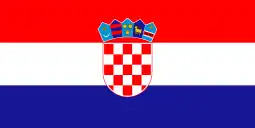 Croatia,
Croatia, 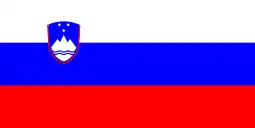 Slovenia,
Slovenia,  Bosnia and Herzegovina) in Yugoslav Wars 1991-2001[10]
Bosnia and Herzegovina) in Yugoslav Wars 1991-2001[10] Democratic Republic of the Congo - (March 23 Movement) in M23 rebellion 2012-2013[11][12]
Democratic Republic of the Congo - (March 23 Movement) in M23 rebellion 2012-2013[11][12]
Operators
 Democratic Republic of the Congo - (March 23 Movement) One seen operated by M23 rebels entering the city of Goma.
Democratic Republic of the Congo - (March 23 Movement) One seen operated by M23 rebels entering the city of Goma. Egypt - Unknown
Egypt - Unknown Iraq - Seen in service at artillery battalion of 9th armoured division.
Iraq - Seen in service at artillery battalion of 9th armoured division. Libya - 110 ordered in 1970 from Czechoslovakia and delivered between 1970 and 1973.[1][13]
Libya - 110 ordered in 1970 from Czechoslovakia and delivered between 1970 and 1973.[1][13] Serbia - 48 in service
Serbia - 48 in service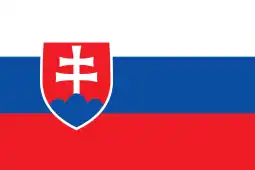 Slovakia - Unknown
Slovakia - Unknown
Former Operators
 Czechoslovakia - Passed on to the successor states.
Czechoslovakia - Passed on to the successor states. Czech Republic - Last vehicle retired from service in 2003.[14]
Czech Republic - Last vehicle retired from service in 2003.[14] Croatia - Two were given to a local army museum, rest was phased out and scrapped.[15]
Croatia - Two were given to a local army museum, rest was phased out and scrapped.[15]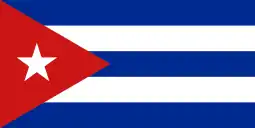 Cuba - Retired
Cuba - Retired Bosnia and Herzegovina - Retired?
Bosnia and Herzegovina - Retired? Slovenia - Retired. Some donated to museums.[16]
Slovenia - Retired. Some donated to museums.[16].svg.png.webp) Yugoslavia - 220 ordered in 1965 from Czechoslovakia and delivered between 1965 and 1968.[1] By 1991 their quantity grew to 789.[17] Passed on to the successor states.[18]
Yugoslavia - 220 ordered in 1965 from Czechoslovakia and delivered between 1965 and 1968.[1] By 1991 their quantity grew to 789.[17] Passed on to the successor states.[18] Syria - Unknown [19]
Syria - Unknown [19].svg.png.webp) Zaire - Unknown[19]
Zaire - Unknown[19]
See also
- BRAMS design successor
- Praga (vehicle works)
References
- 1 2 3 SIPRI Arms Transfers Database
- ↑ Foss, Christopher (1977). Jane's pocket book of towed artillery. New York: Collier. p. 225. ISBN 0020806000. OCLC 911907988.
- ↑ Translation of "Ještěrka"
- ↑ "Militaria Jowitka". Archived from the original on 5 December 2008. Retrieved 28 July 2008.
- ↑ "M53/59".
- ↑ "المدفع المضاد للطائرات M53/59 براجا".
- ↑ "ZSU%20M53%2F59%20Egypt - Google Search".
- ↑ "Identifying the Iraqi Threat and how They Fight". 1990.
- ↑ "AK-Interactive -286 Arab Revolutions & Border Wars Vol.III".
- ↑ "Samohodni PA top Praga M-53/59".
- ↑ "Esoteric Armour: M23 Rebel Group (Democratic Republic of Congo) M53/59 Praga". 12 September 2012.
- ↑ Cooper, Tom (2013). "Africa At War series: Great Lakes Holocaust: The First Congo War 1996–1997" (PDF).
- ↑ "The Lizard is back". 13 October 2013.
- ↑ Ještěrka šířila hrůzu a uprchlíci s ní proráželi železnou oponu (article in Czech)
- ↑ Air Defence weapons of Croatian Army
- ↑ Air Defence weapons of Slovenian Army
- ↑ "Samohodni PA top Praga M-53/59".
- ↑ Air Defence weapons of Yugoslav People's Army
- 1 2 "Ještěrka PLDVK: Protiletadlový komplex z Brna bojoval na Balkáně, v Libyi i v Kongu". 11 July 2017.
External links
- Czech army shooting training
- "M53/59 at ELDON s.r.o". 2003. Archived from the original on 30 September 2007.